
The Callitrichidae are a family of New World monkeys, including marmosets, tamarins, and lion tamarins. At times, this group of animals has been regarded as a subfamily, called the Callitrichinae, of the family Cebidae.

The pied tamarin, sometimes referred to as the Brazilian bare-faced tamarin, is a critically endangered species of primate found in a restricted area of the Brazilian Amazon Rainforest. It was named the mascot of Manaus, Brazil in 2005. The species is endangered due to the increasing size of the city of Manaus which is encroaching on their native habitat.

Geoffroy's tamarin, also known as the Panamanian, red-crested or rufous-naped tamarin, is a tamarin, a type of small monkey, found in Panama and Colombia. It is predominantly black and white, with a reddish nape. Diurnal, Geoffroy's tamarin spends most of its time in trees, but does come down to the ground occasionally. It lives in groups that most often number between three and five individuals, and generally include one or more adults of each sex. It eats a variety of foods, including insects, plant exudates, fruits and other plant parts. Insects and fruits account for the majority of its diet, but exudates are also important. But since its teeth are not adapted for gouging trees to get to the sap, it can only eat exudates when they are easily available.

The tamarins are squirrel-sized New World monkeys from the family Callitrichidae in the genus Saguinus. They are the first offshoot in the Callitrichidae tree, and therefore are the sister group of a clade formed by the lion tamarins, Goeldi's monkeys and marmosets.

Sakis, or saki monkeys, are any of several New World monkeys of the genus Pithecia. They are closely related to the bearded sakis of genus Chiropotes.

The cotton-top tamarin is a small New World monkey weighing less than 0.5 kg (1.1 lb). This New World monkey can live up to 24 years, but most of them die by 13 years. One of the smallest primates, the cotton-top tamarin is easily recognized by the long, white sagittal crest extending from its forehead to its shoulders. The species is found in tropical forest edges and secondary forests in northwestern Colombia, where it is arboreal and diurnal. Its diet includes insects and plant exudates, and it is an important seed disperser in the tropical ecosystem.

The white-lipped tamarin, also known as the red-bellied tamarin, is a tamarin which lives in the Amazon area of Brazil and Bolivia.

The golden-handed tamarin, also known as the red-handed tamarin or Midas tamarin, is a New World monkey belonging to the family Callitrichidae.

Martins's tamarin or Martin's ochraceous bare-face tamarin, is a species of tamarin endemic to Brazil.

The black-mantled tamarin, Leontocebus nigricollis, is a species of saddle-back tamarin from the northwestern Amazon in far western Brazil, southeastern Colombia, north-eastern Peru and eastern Ecuador.

The black tamarin or western black-handed tamarin is a species of tamarin endemic to Brazil.

The brown-mantled tamarin, also known as Spix's saddle-back tamarin, is a species of saddle-back tamarin. This New World monkey is found in the Southern American countries of Bolivia, Brazil and Peru. This omnivorous member of the Callitrichidae family is usually found in smaller groups ranging between 4 and 15 individuals. This species communicates vocally and largely rely their olfactory system. The brown-mantled tamarin is considered as a species of Least Concern by the International Union for Conservation of Nature, despite a decreasing population and being threatened by poaching, habitat loss and capture for the illegal pet trade.

The golden-mantled tamarin is a tamarin species from South America. It is found in Ecuador and Peru, specifically in the upper Amazon (lowland), east of the Andes in Ecuador, and Northeast Peru; between the Rio Curaray and Rio Napo in Peru.

The white-mantled tamarin, Leontocebus weddelli melanoleucus, is a subspecies of Weddell's saddle-back tamarin, a tamarin monkey from South America. It is found in Brazil, between Rio Jurua and Rio Tarauacá.

The red-capped tamarin, is subspecies of moustached tamarin from South America. They are found in Brazil, on the eastern margin of the Tefé and Coari rivers. Previously recognised as a separate species, Saguinus pilatus, the red-capped tamarin was demoted to subspecies status by a taxonomic review by Rylands et al., (2016).

Mico is a genus of New World monkeys of the family Callitrichidae, the family containing marmosets and tamarins. The genus was formerly considered a subgenus of the genus Callithrix.
Amanã Sustainable Development Reserve is a sustainable development reserve in the state of Amazonas, Brazil.

Cruz Lima's saddle-back tamarin is a species of saddle-back tamarin, a type of small monkey from South America. Cruz Lima's saddle-back tamarin was formerly considered to be a subspecies of the brown-mantled tamarin, L. fuscicollis. It lives in Brazil in the area near the Inauini River. Its fur is mostly reddish orange, with a black tail and white eyebrows. The IUCN rates it as least concern from a conservation standpoint.



















